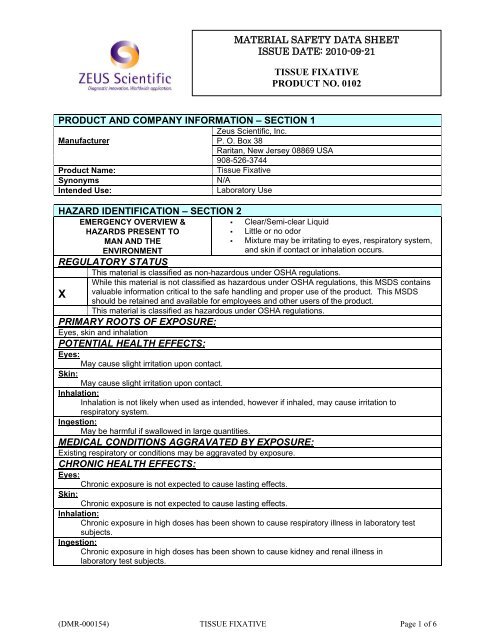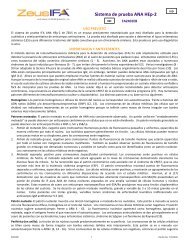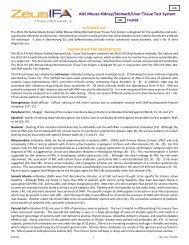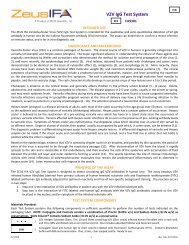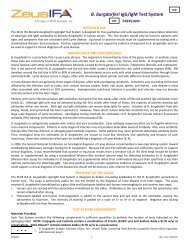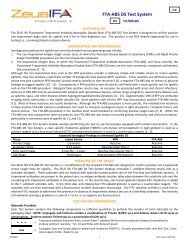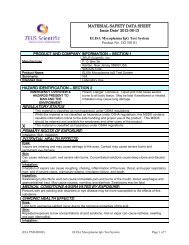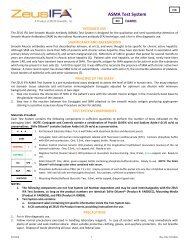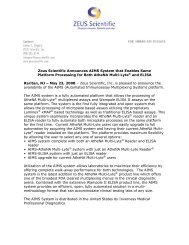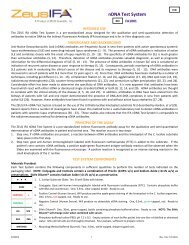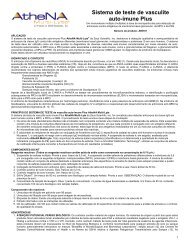MSDS - ZEUS Scientific
MSDS - ZEUS Scientific
MSDS - ZEUS Scientific
Create successful ePaper yourself
Turn your PDF publications into a flip-book with our unique Google optimized e-Paper software.
MATERIAL SAFETY DATA SHEETISSUE DATE: 2010-09-21TISSUE FIXATIVEPRODUCT NO. 0102PRODUCT AND COMPANY INFORMATION – SECTION 1Zeus <strong>Scientific</strong>, Inc.ManufacturerP. O. Box 38Raritan, New Jersey 08869 USA908-526-3744Product Name:Tissue FixativeSynonymsN/AIntended Use:Laboratory UseHAZARD IDENTIFICATION – SECTION 2EMERGENCY OVERVIEW &• Clear/Semi-clear LiquidHAZARDS PRESENT TO• Little or no odorMAN AND THEENVIRONMENT• Mixture may be irritating to eyes, respiratory system,and skin if contact or inhalation occurs.REGULATORY STATUSXThis material is classified as non-hazardous under OSHA regulations.While this material is not classified as hazardous under OSHA regulations, this <strong>MSDS</strong> containsvaluable information critical to the safe handling and proper use of the product. This <strong>MSDS</strong>should be retained and available for employees and other users of the product.This material is classified as hazardous under OSHA regulations.PRIMARY ROOTS OF EXPOSURE:Eyes, skin and inhalationPOTENTIAL HEALTH EFFECTS:Eyes:May cause slight irritation upon contact.Skin:May cause slight irritation upon contact.Inhalation:Inhalation is not likely when used as intended, however if inhaled, may cause irritation torespiratory system.Ingestion:May be harmful if swallowed in large quantities.MEDICAL CONDITIONS AGGRAVATED BY EXPOSURE:Existing respiratory or conditions may be aggravated by exposure.CHRONIC HEALTH EFFECTS:Eyes:Chronic exposure is not expected to cause lasting effects.Skin:Chronic exposure is not expected to cause lasting effects.Inhalation:Chronic exposure in high doses has been shown to cause respiratory illness in laboratory testsubjects.Ingestion:Chronic exposure in high doses has been shown to cause kidney and renal illness inlaboratory test subjects.(DMR-000154) TISSUE FIXATIVE Page 1 of 6
COMPOSITION INFORMATION – SECTION 3Chemical Name:Proprietary MixturePercent:N/ACAS Number:N/ARisk Phrases:R36/37/38(refer to Section 15)Safety PhrasesS24, S25, S28, S36, S37, S39, S46(refer to Section 15)Symbols:(Xi) IrritantEINECS / ELINCS Number: N/AFIRST AID MEASURES – SECTION 4SEEK MEDICAL ATTENTION FOR ALL CASES OF OVEREXPOSUREFIRST AID MEASURES:Eyes:Flush eyes with copious amounts of water for 15 minutes. If irritation persists seekimmediate medical attention.Skin:Wash area of exposure thoroughly with soap and water. Remove contaminated clothing andpersonal protective equipment. If irritation persists seek immediate medical attention.Inhalation:Inhalation is not expected to occur when used as intended. If inhalation occurs, move victim tofresh air. See medical attention if symptoms persist.Ingestion:Ingestion of small amounts may cause gastrointestinal irritation. If small quantities are ingesteddrink copious amounts of water. If large quantities are ingested, seek medical attention. Ifsymptoms persist, seek medical attention.Instructions for Physician:No additional instructions.FIRE FIGHTING MEASURES – SECTION 5NFPA ClassificationHealth Fire Reactivity Other1 0 0 N/AFLAMMABILITY PROPERTIESFlash Point: N/A Method: N/AFlammability Limits: (in air % by volume) LEL: N/A UEL: N/AAutoignition Temperature:N/AHazardous Combustion Products:Carbon dioxide may emit trace amounts of toxic vapors and fumes.Extinguishing Media:Water, foam, carbon dioxide, or dry chemical.Prohibited Extinguishing Media:None identified.Firefighting Instructions:Prevent contact of material with eyes and skin. Prevent inhalation of toxic vapors. Wear selfcontainedbreathing apparatus and protective clothing to prevent inhalation and contactwith material.Unusual Fire and Explosion Hazards:None identified.(DMR-000154) TISSUE FIXATIVE Page 2 of 6
ACCIDENTAL RELEASE MEASURES – SECTION 6Personnel Precautions:Utilize necessary laboratory PPE when handling spills.Environmental Precautions:Do not allow large quantities to drain into surface waters.Cleanup Methods:• For small spills, absorb with absorbent rags and dispose of in accordance with Local, State andFederal regulations.• For large spills, contain using absorbent materials and dispose of in accordance with Local,State, and Federal regulations.HANDLING AND STORAGE – SECTION 7Handling:Avoid contact with eyes and skin. Utilize recommended PPE. Avoid repeated, prolonged exposure.Storage:Maintain containers in a cool, well-ventilated area which is protected from light exposure.Containers should remain sealed while in storage.Specific Uses:Product is intended for laboratory use.EXPOSURE CONTROLS/PERSONAL PROTECTION – SECTION 8EXPOSURE CONTROLS:Exposure Limit Values:No information available.Engineering Controls:General ventilation is sufficient for the handling and storage of the material. Facilities handling thisproduct should be equipped with a safety shower and eye wash station in compliance withANSI standards.PERSONAL PROTECTIVE EQUIPMENT:Respiratory Protection:Respiratory protection not required when used as intended. If exposure limits are exceeded,Wear a NIOSH approved respirator to maintain exposure levels below maximum values.Hand Protection:Laboratory PPE, including gloves should be utilized when handling the material.Eye/Face Protection:Laboratory PPE, including goggles should be utilized when handling the material.Skin Protection:Laboratory PPE, including lab coat should be utilized to protect from skin contact.General Hygiene Considerations:Avoid ingestion, inhalation, or contact with eyes and skin. Wash hands thoroughly after use.Other Protective Equipment:No additional PPE required.PHYSICAL & CHEMICAL PROPERTIES – SECTION 9PRODUCT:Tissue FixativeGeneral Information:AppearanceClear/Semi-Clear LiquidOdorLittle or no odor(DMR-000154) TISSUE FIXATIVE Page 3 of 6
Important Health, Safety, and Environmental Information:Boiling PointMelting PointFlash PointExplosive PropertiesOxidizing PropertiesSpecific Gravity (H 2 O = 1)No information available.Water SolubilityPartition Coefficient (n-octanoll water)ViscosityVapor Pressure (mm Hg)Vapor Density (Air = 1)Evaporation Rate% Volatile (By Volume @ 68ºF)STABILITY & REACTIVITY – SECTION 10Stability:Stable under normal conditions.Conditions to Avoid:Extreme temperatures.Materials to Avoid:Avoid contact with strong oxidizing agents, metals, strong acids, and strong bases.Hazardous Decomposition Products:Irritating toxic fumes and gases, carbon monoxide, carbon dioxide, and sulfur oxides.Hazardous Polymerization:Will not occur.TOXICOLOGICAL INFORMATION – SECTION 11Type of Test Route of Exposure Effects Species Observed Dose DataTween 20:LD 50 Oral Lethal Dose Rodent – rat 36,7000 ul/kgTD LO Oral Gastrointestinaleffects, HypermobilitySodium Chloride:LD 50 Oral Details of toxiceffects not reportedother than lethal dosevalueSodium Azide:LD 50 Oral Details of toxic effectsnot reported otherthan lethal dose valueRodent – rat 832gm/kg/59D-CRodent – ratRodent – RatECOLOGICAL INFORMATION – SECTION 12Ecotoxicity:May be slightly toxic to aquatic organisms. Avoid discharge into surface waters.Mobility:No information available.Persistence and Degradability:No information available.Bioaccumulative Potential:No information available.3000 mg/kg27 mg/kg(DMR-000154) TISSUE FIXATIVE Page 4 of 6
DISPOSAL CONSIDERATION – SECTION 13Disposal should be in accordance with Local, State, and Federal regulations.TRANSPORT INFORMATION – SECTION 14DOT CLASSIFICATION:UN Number:Class:Proper Shipping Name:Packing Group:Not regulated for transport.Marine Pollutant:Other Information:IATA CLASSIFICATION:UN Number:Class:Proper Shipping Name:Packing Group:Not regulated for transport.Marine Pollutant:Other Information:IMDG CLASSIFICATION:UN Number:Class:Proper Shipping Name:Packing Group:Not regulated for transport.Marine Pollutant:Other Information:REGULATORY INFORMATION – SECTION 15U.S. REGULATIONSACGIHCAA Section 112CERCLAIARCNot ListedNTPOSHASARA Title IIITSCACasitone, Tween-20, Sodium Chloride.STATE REGULATIONSMA Substance ListNJ RTK Hazardous Substance List Not ListedPA Hazardous Substance ListCanadian WHMISEUROPEAN UNIONRisk Phrases:R36/37/38 Irritating to eyes, respiratory system and skin.Safety Phrases:S24: Avoid contact with skinS25: Avoid contact with eyesS28: After contact with skin, wash immediately with plenty of waterS36: Wear suitable protective clothingS37: Wear suitable glovesS39: Wear eye/face protectionS46: If swallowed, seek medical advice immediately.(DMR-000154) TISSUE FIXATIVE Page 5 of 6
Hazard Symbols:(Xi) IrritantUse Restrictions:No restrictionsOTHER INFORMATION – SECTION 16Revision NumberRevision Date2 2010-09-21• Each donor unit used in the preparation of the controls was tested by an FDA approved method forthe presence of antibody to HIV-1, HIV-2, and HCV, as well as Hepatitis B surface antigen, and foundto be negative (not repeatedly reactive).• This product contains albumin from bovine serum. It was derived from bovine blood collected at aUSDA licensed establishment. All donor animals were a source of the United States, a country inwhich Bovine Spongiform Encephalopathy is not known to exist.• To the best of our knowledge, the information contained herein is accurate. However, neither Zeus<strong>Scientific</strong>, Inc. nor any of its subsidiaries assumes any liability whatsoever for the accuracy orcompleteness of the information contained herein. Final determination of suitability of any material isthe sole responsibility of the user. All materials may present unknown hazards and should be usedwith caution. Although certain hazards are described herein, we cannot guarantee that these are theonly hazards that exist.• <strong>MSDS</strong> documents for individual kit components are available upon request.(DMR-000154) TISSUE FIXATIVE Page 6 of 6


